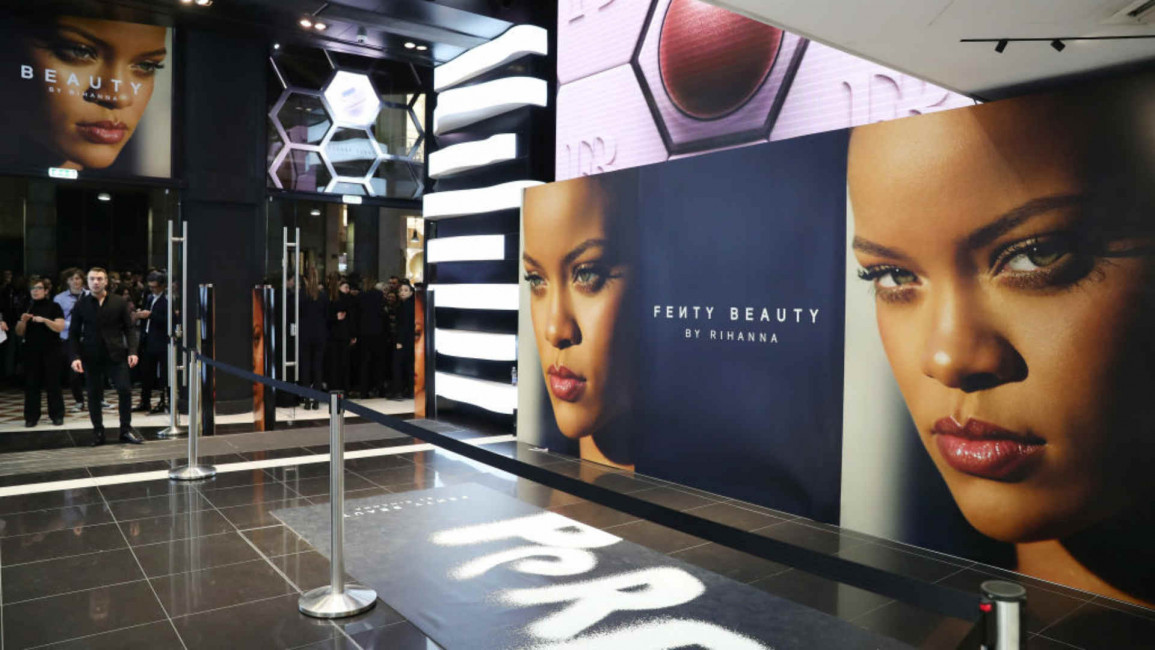
Rihanna's Moroccan Spice eyeshadow: Shades of cheap Arab tokenism
Fenty Beauty has previously been hailed for its inclusivity; it launched last September with a foundation range available in 40 shades, making it far more accessible to people of colour than its competitors.
It is, therefore, disappointing to see an enterprising brand descend into cheap tokenism with the release of Moroccan Spice. The sixteen-colour palette exemplifies the misrepresentation of the Arab world; an advert for the product features dramatic Arab fusion music, swirling desert imagery, models wearing her makeup, and - in case we didn't quite catch the Orientalism at play - a camel for good measure.
The slope between appreciation and appropriation is a slippery one.
The Moroccan Spice does nothing to acknowledge true Moroccan culture. Instead it cracks cheap puns that betrays Fenty's lack of understanding or research on North Africa, while benefiting from the on-trend Arabian imagery that clearly lacks any input by Moroccans.
In fact, Fenty Beauty isn't even available in Morocco. If taking advantage of (inaccurate) Moroccan imagery for commercial gain is not appropriation, then I don't know what is. This launch promotes stereotypes that are at odds with everyday Arabs, without acknowledging the damaging effect this misinformation can have on their lives.
Twitter Post
|
When Arab women cover their heads or wear loose shawls they are demonised as backwards and told to integrate, but when a western beauty line does the same - showing the necessary skin to make the Arab iconography more palatable - it is dramatic, fashionable and edgy.
And I don't know a single Arab woman who wasn't harassed at school with taunts about camels.
There is, happily, a long history of cheeky puns in the beauty world. Skincare and makeup brand Soap and Glory are well known for their tongue-in-cheek wordplay, such as a brow crayon called Arch de Triumph, or their Pulp Friction body scrub. It is harmless fun.
But Fenty's Moroccan Spice is unable to avoid sinking into stereotypes and ignorance.
It's also all a bit obvious and cringeworthy. Their colours are named, ranging from the more tolerable (though, strangely dusky pink) Saffron, to the inevitable desert references – Sahara Stunna and Desert Baked to the outright Orientalist Evil Genie, Fez up and Souq It to Me.
Then there are the inaccuracies of Shisha Smoke (shisha is not really part of the Moroccan culture as it is in the Middle East) and Quick Sand (presumably because Fenty believes that there is quicksand in the Sahara…)
Fenty's previous range, Beach, Please was far more suited to the cavalier naming as it did not run the risk of (mis)representing an entire country through its enticing names, such as Mimosa Sunrise and Poolside.
The Moroccan Spice palette picks and chooses from across the Arab World and - in the case of Evil Genie - adds a dash of fetishisation and presents it with the same gravity as it does a beach-themed range. Offhand quips and inaccurate wordplay, when focused on an already misunderstood and maligned people - particularly for Moroccans and Arabs in Europe and the United States - has consequences.
It is a missed opportunity, too. Done with consideration, the line could have proved tasteful while retaining its desired whimsy. Fenty tells buyers to 'savour the flavors of Morocco' without actually presenting them.
 |
In case we didn't quite catch the Orientalism at play, there's a camel for good measure |  |
Morocco is, indeed, rich in herbs and spices, but Moroccan Spice only names two of the sixteen eyeshadow colours after any spices at all.
Most famous among Morocco's spices is Ras el Hanout, which presumably didn't have the same puntential as Cumin Get It, which is, admittedly, an amusing name.
Twitter Post
|
The North African country is also known for its dried rose petals, star anise, cinnamon sticks and Paprika. It also produces a wealth of other high quality natural products including Eucalyptus Crystals, Argan Oil, Ghassoul Clay and an array of infused hamam soaps.
If Fenty wishes to profit from so-called Moroccan herbs and spices, they could have at the very least done a quick Google search. Better yet, actually visit the country you're planning to represent in a single palette.
But its unlikely Fenty was interested in accurately representing a country, they were focused on selling products, creating hype, and successfully achieved this by skewing the associations with Morocco in order to present a fetishised version of Arabs; one that confirms the stereotypes that many in their target audience already hold.
Ruqaya Izzidien is a British-Iraqi freelance writer specialising in social and cultural affairs. Her work has been published in The New York Times, the Guardian, the BBC and Al Jazeera English, and her upcoming novel is entitled The Watermelon Boys.
Follow her on Twitter: @RuqayaIzzidien
Opinions expressed in this article remain those of the author, and do not necessarily represent those of The New Arab, its editorial board or staff.


![President Pezeshkian has denounced Israel's attacks on Lebanon [Getty]](/sites/default/files/styles/image_684x385/public/2173482924.jpeg?h=a5f2f23a&itok=q3evVtko)



 Follow the Middle East's top stories in English at The New Arab on Google News
Follow the Middle East's top stories in English at The New Arab on Google News


